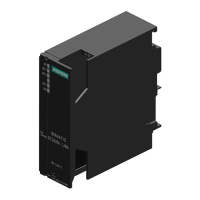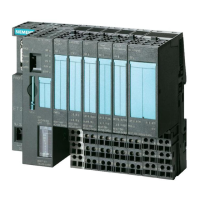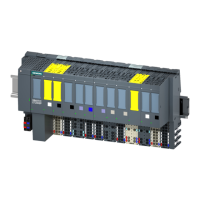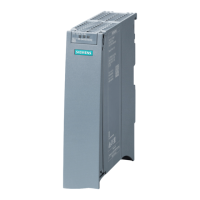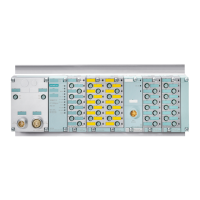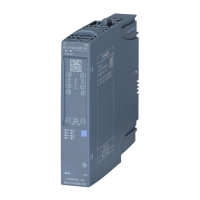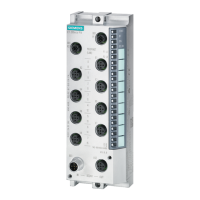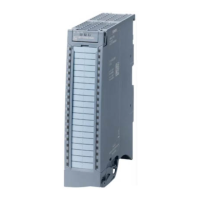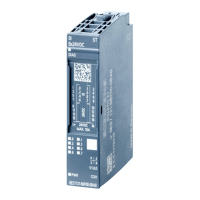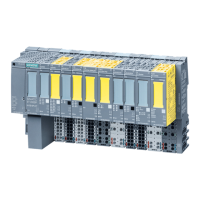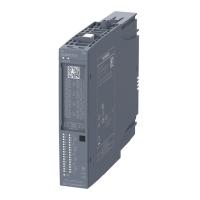Do you have a question about the Siemens SIMATIC ET 200AL and is the answer not in the manual?
Explains the meaning of danger, warning, caution, and notice symbols.
Defines personnel qualifications and notes on product usage.
Explains the manual's role in supplementing the system manual.
Notes on symbols, formatting, and Siemens' industrial security.
Describes the arrangement into General, Device, and Basic information.
Accessing personal workspace and practical automation examples.
Tool for selecting, configuring, and ordering TIA devices.
Tool for commissioning and maintenance of SIMATIC S7 stations.
Network analysis tool for PROFINET systems.
Network planner for PROFINET installations.
Lists technical properties of the digital input/output module.
Lists components included in the package and available as spare parts.
Lists other components and points to the system manual.
Identifies LEDs, sockets, and connectors on the module.
Explains available modes like DIQ, DQ16, DI8/DQ8, DIQ MIX.
Illustrates pin assignments and connections for various modes.
Details pin assignments for sockets X10-X13 in DIQ modes.
Details pin assignments for sockets X10-X13 in DQ16 mode.
Details pin assignments for sockets X10-X13 in DI8/DQ8 mode.
Details pin assignments for sockets X10-X13 in DIQ MIX mode.
Details pin assignments for ET-Connection and supply voltage connectors.
Details pin assignments for power input and output connectors.
Lists module parameters, their value ranges, defaults, and scope.
Provides detailed explanations for module parameters.
Shows process image input/output assignments in DIQ mode.
Shows process image assignments with value status in DIQ mode.
Shows process image assignments for DI8/DQ8 and DIQ MIX modes.
Explains how to interpret value status bits for error detection.
Shows the module's LEDs for status and error indication.
Explains the meaning of DIAG, Channel Status, and PWR LEDs.
Describes module interrupts and lists diagnostic alarms.
Explains the module's counting capabilities and event detection.
Details configuration of counter limits and start values.
Explains gate control and direction settings for counters.
Compares properties of 2xCount and 4xCount methods.
Shows pin assignments and block diagrams for 2xCount.
Details pin assignments for counting channels X10-X13.
Details pin assignments for sockets X14-X17 and ET-Connection.
Lists general parameters like diagnostics and CPU/master STOP behavior.
Details parameters for Counter 0 and Counter 1.
Details parameters for channels 8-15.
Explains diagnostic and CPU/master STOP parameters.
Explains input delay and counting direction parameters.
Explains edge selection, limit behavior, comparison, start, and count limits.
Explains DQ behavior, interrupts, STOP behavior, and DI gate control.
Explains DI direction input and parameters for channels 8-15.
Shows address space for controlling counters and channels 8-15.
Explains control bits for SLOT, LD_SLOT, SW_GATE, and reset events.
Shows address space for receiving counter values and status.
Explains feedback bits for count value, status, gate, load, and event status.
Illustrates the acknowledgment principle for event bits.
Shows the module's LEDs for status and error indication.
Explains the meaning of DIAG, Channel Status, and PWR LEDs.
Describes module interrupts for 2xCount.
Lists alarm codes and corrective measures.
Shows pin assignments and block diagrams for 4xCount.
Details pin assignments for counting channels X10-X13.
Details pin assignments for sockets X14-X17 and ET-Connection.
Lists general parameters like diagnostics and CPU/master STOP behavior.
Details parameters for Counters 0 to 3.
Details parameters for channels 8-15.
Explains diagnostic and CPU/master STOP parameters.
Explains input delay, direction, edge selection, and limit behavior.
Explains DQ behavior, interrupts, STOP behavior, and channel assignments.
Shows address space for controlling counters and channels 8-15.
Explains control bits for SLOT, LD_SLOT, SW_GATE, and reset events.
Shows address space for receiving counter values and status.
Explains feedback bits for count value, status, gate, load, and event status.
Illustrates the acknowledgment principle for event bits.
Shows the module's LEDs for status and error indication.
Explains the meaning of DIAG, Channel Status, and PWR LEDs.
Describes module interrupts for 4xCount.
Lists alarm codes and corrective measures.
Shows DQ behavior between comparison and high limit in forward direction.
Shows DQ behavior between comparison and low limit in backward direction.
Illustrates starting/stopping counting via gate control.
Shows changing counting direction and stopping counting.
Explains stopping counting when a limit is exceeded (forward).
Explains continuing counting when a limit is exceeded (backward).
Covers article number, designation, function, and I&M data.
Details input current, encoder supply specs, and digital input characteristics.
Details digital output specifications like number, protection, and switching frequency.
Covers interrupts, diagnostics, ambient conditions, and dimensions.
Introduces PROFlenergy as an interface for switching off consumers during pauses.
Explains digital input behavior during PROFlenergy pause modes.
Explains digital output behavior during PROFlenergy pause modes.
Explains PROFlenergy behavior for counter inputs.
Details the Mode parameter for counter inputs.
Shows front and side views with overall dimensions of the module.
Explains the meaning of danger, warning, caution, and notice symbols.
Defines personnel qualifications and notes on product usage.
Explains the manual's role in supplementing the system manual.
Notes on symbols, formatting, and Siemens' industrial security.
Describes the arrangement into General, Device, and Basic information.
Accessing personal workspace and practical automation examples.
Tool for selecting, configuring, and ordering TIA devices.
Tool for commissioning and maintenance of SIMATIC S7 stations.
Network analysis tool for PROFINET systems.
Network planner for PROFINET installations.
Lists technical properties of the digital input/output module.
Lists components included in the package and available as spare parts.
Lists other components and points to the system manual.
Identifies LEDs, sockets, and connectors on the module.
Explains available modes like DIQ, DQ16, DI8/DQ8, DIQ MIX.
Illustrates pin assignments and connections for various modes.
Details pin assignments for sockets X10-X13 in DIQ modes.
Details pin assignments for sockets X10-X13 in DQ16 mode.
Details pin assignments for sockets X10-X13 in DI8/DQ8 mode.
Details pin assignments for sockets X10-X13 in DIQ MIX mode.
Details pin assignments for ET-Connection and supply voltage connectors.
Details pin assignments for power input and output connectors.
Lists module parameters, their value ranges, defaults, and scope.
Provides detailed explanations for module parameters.
Shows process image input/output assignments in DIQ mode.
Shows process image assignments with value status in DIQ mode.
Shows process image assignments for DI8/DQ8 and DIQ MIX modes.
Explains how to interpret value status bits for error detection.
Shows the module's LEDs for status and error indication.
Explains the meaning of DIAG, Channel Status, and PWR LEDs.
Describes module interrupts and lists diagnostic alarms.
Explains the module's counting capabilities and event detection.
Details configuration of counter limits and start values.
Explains gate control and direction settings for counters.
Compares properties of 2xCount and 4xCount methods.
Shows pin assignments and block diagrams for 2xCount.
Details pin assignments for counting channels X10-X13.
Details pin assignments for sockets X14-X17 and ET-Connection.
Lists general parameters like diagnostics and CPU/master STOP behavior.
Details parameters for Counter 0 and Counter 1.
Details parameters for channels 8-15.
Explains diagnostic and CPU/master STOP parameters.
Explains input delay and counting direction parameters.
Explains edge selection, limit behavior, comparison, start, and count limits.
Explains DQ behavior, interrupts, STOP behavior, and DI gate control.
Explains DI direction input and parameters for channels 8-15.
Shows address space for controlling counters and channels 8-15.
Explains control bits for SLOT, LD_SLOT, SW_GATE, and reset events.
Shows address space for receiving counter values and status.
Explains feedback bits for count value, status, gate, load, and event status.
Illustrates the acknowledgment principle for event bits.
Shows the module's LEDs for status and error indication.
Explains the meaning of DIAG, Channel Status, and PWR LEDs.
Describes module interrupts for 2xCount.
Lists alarm codes and corrective measures.
Shows pin assignments and block diagrams for 4xCount.
Details pin assignments for counting channels X10-X13.
Details pin assignments for sockets X14-X17 and ET-Connection.
Lists general parameters like diagnostics and CPU/master STOP behavior.
Details parameters for Counters 0 to 3.
Details parameters for channels 8-15.
Explains diagnostic and CPU/master STOP parameters.
Explains input delay, direction, edge selection, and limit behavior.
Explains DQ behavior, interrupts, STOP behavior, and channel assignments.
Shows address space for controlling counters and channels 8-15.
Explains control bits for SLOT, LD_SLOT, SW_GATE, and reset events.
Shows address space for receiving counter values and status.
Explains feedback bits for count value, status, gate, load, and event status.
Illustrates the acknowledgment principle for event bits.
Shows the module's LEDs for status and error indication.
Explains the meaning of DIAG, Channel Status, and PWR LEDs.
Describes module interrupts for 4xCount.
Lists alarm codes and corrective measures.
Shows DQ behavior between comparison and high limit in forward direction.
Shows DQ behavior between comparison and low limit in backward direction.
Illustrates starting/stopping counting via gate control.
Shows changing counting direction and stopping counting.
Explains stopping counting when a limit is exceeded (forward).
Explains continuing counting when a limit is exceeded (backward).
Covers article number, designation, function, and I&M data.
Details input current, encoder supply specs, and digital input characteristics.
Details digital output specifications like number, protection, and switching frequency.
Covers interrupts, diagnostics, ambient conditions, and dimensions.
Introduces PROFlenergy as an interface for switching off consumers during pauses.
Explains digital input behavior during PROFlenergy pause modes.
Explains digital output behavior during PROFlenergy pause modes.
Explains PROFlenergy behavior for counter inputs.
Details the Mode parameter for counter inputs.
Shows front and side views with overall dimensions of the module.
| Brand | Siemens |
|---|---|
| Model | SIMATIC ET 200AL |
| Category | I/O Systems |
| Language | English |
